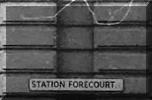

A story by John Wilkinson.
BUTTERSHAW BACK THEN
Although I lived in Shelf for 22 years, I can lay claim to being a Bradfordian- having been born at 19 Manorley Lane, Buttershaw on 21st June 1930. My parents moved to Shelf when I was six months old into what had been the Counting House for the local iron works. The remains of the Old Blast Furnace existed close by until the land was taken over for re-development in recent years.
Blackshaw Beck – the boundary between the two villages- ran close to our house and at one point our garden wall was anchored in the stream. It should be explained that the house was elevated above stream level and the garden walls were ten feet high.
Buttershaw came under the control of Bradford Urban District Council, while Shelf was under the control of Queensbury and Shelf Rural District Council. Although classed as urban, Buttershaw was as rural as it’s neighbour, having fields on all side reaching as far as Beacon Hill, Wibsey and Low Moor.
From our front window we looked across the stream to Dunn Ridsdale’s Dyeworks- who’s chimney still exists- and the houses in Farfield Road, leading to Beck Hill, that were almost obscured by the ‘Pit Hills’ (slag heaps) a relic of local mining, or foundry waste. It was quite an event in the late forties when the gigantic earth movers came along and levelled the site to make way for the Buttershaw Council Estate. I was, at that time, working for the Buttershaw and Wibsey Co-Op on Halifax Road, at the bottom of Queens Street, now a hire shop. The head office branch was at Beacon Road, Wibsey- still a Co-Op but now a late night store- and another on North Road, Wibsey- now the Conservative Club. The Buttershaw branch could almost be described as the ‘Hub of the Community’ for there was the notorious ‘Co-Op seat’ The seat was a bench about nine or ten feet long, where customers could rest while waiting to be served. Here all the local gossip was aired and woe betide anyone who became the subject of the latest news, for these gatherings often assumed the mantle of a Kangaroo Court, and mud thrown from here would really stick. It was not unusual for the staff to be told to wait by a customer not wanting to miss “the latest.”
These were the days of rationing where most things were in short supply and fresh foods were only available in season- lacking today’s modern growing techniques.
Trams ran through the village, terminating at the Bottomleys Arms in Shelf
Ridsdale Dyeworks and Bottomleys Mill were the biggest employers, with Farming contributing to the local workforce.
I recall the anger and complaints when the bus fare to Bradford was increased to twopence-halfpenny (one new pence)
Looking back, these were hard but happy days where you made your own entertainment. I can’t help feeling that we were all the better for it.
© John Wilkinson. 2006
my great grandfather Daniel Askham living and working in Buttershaw in1902. A Story sent to us by David Wilkinson. 2014
BRADFORD DAILY ARGUS MAY 2nd 1902 page 4
The Buttershaw Sensation.
----------------------
A Terrible Affair
-------------------
Two men suffocated
---------------------
Gallant Rescue Attempt
The rural district of Buttershaw was the scene of a catastrophe yesterday, which resulted in the death of two men. The details of the incident were published in the “ARGUS” yesterday. The story of the affair briefly is that Enoch Hartley was engaged in cleaning out a huge “still” or vat at the chemical works of Mr Thomas Johnson and Exors, of Buttershaw, when he suddenly fell down as though overpowered. There are pipes connected with the vat for the purpose of taking off the sulphurous gases arising the burning of tar and it is conjectured that a quantity of gas had worked back along these pipes and had filled the vat.
Hartley was handing up tools to another man Arthur Warbrick when he fell, and the latter realising the situation, at once raised an alarm.
SOME VAIN ATTEMPTS.
A man named Daniel Askham gallantly undertook the perilous task of rescuing Hartley, but the noble effort cost him his life. Askham descended into the death-pit by means of a ladder, but after a plucky attempt to rescue Hartley he felt his strength going and tried to ascend the ladder. He failed to reach the top, however, for he fell back unconscious, by the side of the man whom he had attempted to rescue.
Then Warbrick, with commendable courage undertook the terrible task, but this time a wise precaution was taken. A rope was fastened around the rescuers body, and he was held by that as he descended. Before he reached the bottom his head dropped, and he had to be pulled up again. It was plain that no human being could live in that awful pit more than a few minutes.
New methods were resorted to with some success. A slip –knot was looped on Askham’s leg, with the aid of a long pole and the body was pulled out of the pit. The same device proved successful in the case of Hartley.
Doctors MaClachlen and Thompson were sent for but after the application of artificial respiration
ALL HOPE WAS ABANDONED of restoring Hartley.
Askham showed signs of life however, and was taken to the Royal Infirmary in horse ambulance, but died about an hour after admission.
The body of Hartley now lies at the public mortuary Bradford.
Hartley who was thirty years of age, and who lived at Furnace Yard Shelf was a single man. Daniel Askham who lived at Princess Street, Buttershaw leaves a widow and three small children. Blackshaw Beck Chemical Work’s belongs to Mr Thomas Johnson and Exors. They have carried on business at these works since 1855, and nothing of this nature has ever occurred before.
Here are some pictures donated to the website from David Wilkinson Johns Son. 2014.
Click on the small image to get a ful size wiew.
Back to Buttershaw and Shelf pics.